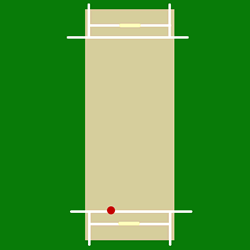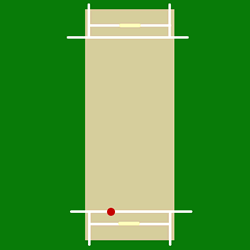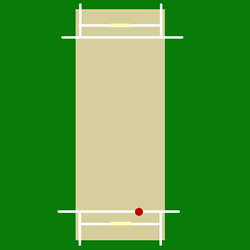
Leg spin is a type of spin bowling in cricket. A leg spinner bowls right-arm with a wrist spin action. The leg spinner's normal delivery causes the ball to spin from right to left in the cricket pitch when the ball bounces. For a right-handed batsman, that is away from the leg side, and this is where it gets the name leg break, meaning it breaks away from the leg. The turn is mostly when the ball pitches.
The flipper is the name of a particular bowling delivery used in cricket, generally by a leg spin bowler. In essence it is a back spin ball. Squeezed out of the front of the hand with the thumb and first and second fingers, it keeps deceptively low after pitching and can accordingly be very difficult to play. The flipper is comparable to a riseball in fast-pitch softball.

Off spin is a type of finger spin bowling in cricket. A bowler who uses this technique is called an off spinner. Off spinners are right-handed spin bowlers who use their fingers to spin the ball. Their normal delivery is an off break, which spins from left to right when the ball bounces on the pitch. For a right-handed batsman, this is from his off side to the leg side. The ball breaks away from the off side, hence the name 'off break'.

Bowling, in cricket, is the action of propelling the ball toward the wicket defended by a batter. A player skilled at bowling is called a bowler; a bowler who is also a competent batter is known as an all-rounder. Bowling the ball is distinguished from throwing the ball by a strictly specified biomechanical definition, which restricts the angle of extension of the elbow. A single act of bowling the ball towards the batsman is called a ball or a delivery. Bowlers bowl deliveries in sets of six, called an over. Once a bowler has bowled an over, a teammate will bowl an over from the other end of the pitch. The Laws of Cricket govern how a ball must be bowled. If a ball is bowled illegally, an umpire will rule it a no-ball. If a ball is bowled too wide of the striker for the batsman to be able to play at it with a proper cricket shot, the bowler's end umpire will rule it a wide.
A topspinner is a type of delivery bowled by a cricketer bowling either wrist spin or finger spin. In either case, the bowler imparts the ball with top spin by twisting it with his or her fingers prior to delivery. In both cases, the topspinner is the halfway house between the stock delivery and the wrong'un - in the wrist spinner's case his googly, and in the finger spinner's case his doosra.
In cricket, underarm bowling is as old as the sport itself. Until the introduction of the roundarm style in the first half of the 19th century, bowling was performed in the same way as in bowls, the ball being delivered with the hand below the waist. Bowls may well be an older game than cricket and it is possible that cricket was derived from bowls by the intervention of a batsman trying to stop the ball reaching its target by hitting it away, though bowling per se continued as in bowls.

This is a general glossary of the terminology used in the sport of cricket. Where words in a sentence are also defined elsewhere in this article, they appear in italics. Certain aspects of cricket terminology are explained in more detail in cricket statistics and the naming of fielding positions is explained at fielding (cricket).
In cricket, a no-ball is an illegal delivery to a batsman. It is also the Extra run awarded to the batting team as a consequence. For most cricket games, especially amateur the definition of all forms of no-ball is from the MCC Laws of Cricket
In cricket, a yorker is a ball bowled which hits the cricket pitch around the batsman's feet. When a batsman assumes a normal stance, this generally means that the cricket ball bounces on the cricket pitch on or near the batsman's popping crease. A batsman who advances down the pitch to strike the ball may by so advancing cause the ball to pitch at or around his feet and may thus cause himself to be "yorked".

Pace bowling is one of two main approaches to bowling in the sport of cricket, the other being spin bowling. Practitioners of pace bowling are usually known as fast bowlers, quicks, or pacemen. They can also be referred to as a seam bowler, a swing bowler or a fast bowler who can swing it to reflect the predominant characteristic of their deliveries. Strictly speaking, a pure swing bowler does not need to have a high degree of pace, though dedicated medium-pace swing bowlers are rarely seen at Test level these days.
Swing bowling is a technique used for bowling in the sport of cricket. Practitioners are known as swing bowlers. Swing bowling is generally classed as a subtype of fast bowling.

Spin bowling is a bowling technique in cricket, in which the ball is delivered slowly but with the potential to deviate sharply after bouncing, and the bowler is referred to as a spinner.
In the sport of cricket, a slower ball is a slower-than-usual delivery from a fast bowler. The bowler's intention is to deceive the batsman into playing too early so that he either misses the ball completely or hits it high up in the air to offer an easy catch. It is analogous to a changeup in baseball.

A delivery or ball in cricket is a single action of bowling a cricket ball toward the batsman.

Stumped is a method of dismissing a batsman in cricket, which involves the wicket-keeper putting down the wicket while the batsman is out of his ground.. The action of stumping can only be performed by a wicket-keeper, and can only occur from a legitimate delivery, while the batsman is not attempting a run; it is a special case of a run out.

Wrist spin is a type of bowling in the sport of cricket. It refers to the cricket technique and specific hand movements associated with imparting a particular direction of spin to the cricket ball. The other spinning technique, usually used to spin the ball in the opposite direction, is finger spin. Wrist spin is bowled by releasing the ball from the back of the hand, so that it passes over the little finger. Done by a right-handed bowler, this imparts an anticlockwise rotation to the ball, as seen from the bowler's perspective; a left-handed wrist spinner rotates the ball clockwise.
Finger spin is a type of bowling in the sport of cricket. It refers to the cricket technique and specific hand movements associated with imparting a particular direction of spin to the cricket ball. The other spinning technique, generally used to spin the ball in the opposite direction, is wrist spin. Although there are exceptions, finger spinners generally turn the ball less than wrist spinners. However, because the technique is simpler and easier to master, finger spinners tend to be more accurate.
Line and length in cricket refers to the direction and point of bouncing on the pitch of a delivery. The two concepts are frequently discussed together.
In cricket a bowling machine is a device which enables a batsman to practice and to hone specific skills through repetition of the ball being bowled at a certain length, line and speed. It can also be used when there is no-one available to bowl, or no one of the desired style or standard.

In ball sports, topspin is a property of a ball that rotates forwards as it is moving. Topspin on a ball propelled through the air imparts a downward force that causes the ball to drop, due to its interaction with the air. Topspin is the opposite of backspin.








